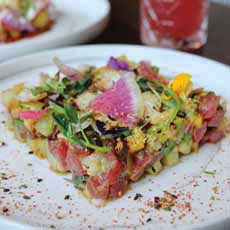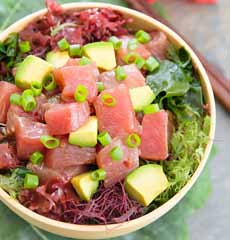FOOD FUN: Re-Flavor & Re-Shape Your Food
 [1] The poke square, a creative version of the poke bowl (photo by Allison Tong for Rooh | Flavor And The Menu).
|
Over the past few years, poke bowls have swept west from Hawaii to the East Coast.
Poke is a raw fish and vegetable dish served as an appetizer or salad course in Hawaiian cuisine. A relative of ceviche, crudo, tartare and tataki, poke is a combination of raw fish and vegetables, served as a light lunch or appetizer. Poke is Hawaiian for “to section” or “to slice or cut.” The most popular recipe, ahi poke, is made with yellowfin tuna marinated in sea salt, plus soy sauce, roasted crushed candlenut (inamona), sesame oil, limu seaweed and chopped chili pepper. You can customize poke however you like, using local or seasonal ingredients. For vegetarians, here’s a tofu poke recipe. Actually pronounced poe-KEH, it is mis-pronounced POE-key or POE-kay by enough people that the latter pronunciation is becoming an accepted alternative outside of the Hawaiian Islands. Poke is Hawaiian for “to section” or “to slice or cut.” Here’s more about it. Sujan Sarkar, Executive Chef at Indian bistro Rooh in San Francisco, re-shapes poke as Tuna Bhel, an Indian-seasoned version of the dish. Inspired by bhel puri, a traditional Indian chaat* made from puffed rice, vegetables and tamarind sauce, Chef Sarkar took the traditional poke base of ahi tuna and mixed it with puffed black rice, crunchy chickpea snack, boiled potatoes, red onion, green apple and green mango, baby radish and avocado. He then seasoned the medley with seasoned with chaat masala, chutney, and a sprinkle of the Japanese chile-based spice mix, shichimi togarashi, on the plate. |
|
|
He not only uses Indian ingredients; he elevated the eye appeal from a bowl to a plate, elegantly shaped with a square egg ring. You, too can create a designer poke dish (or apply the lesson to any other conventional food preparation). Take this poke recipe from Kirbie Cravings (photo #2) and think of what flavors you’d like to add. Avocado and scallions are popular, but how about: In his presentation, Chef Sarkar garnishes with watermelon radishes and edible flowers. Here, you can use something fun and crunchy (freeze-dried edamame?). ________________ *Chaat are savory snacks that originated as Indian street food. They are now served as hors d’oeuvres or first courses in Indian restaurants. The word derives from Hindi for tasting. More about chaat.
|
||



